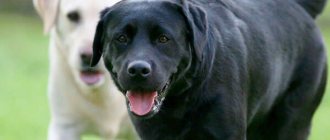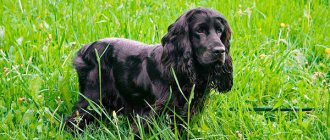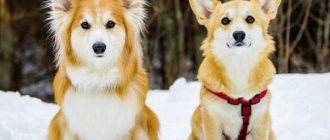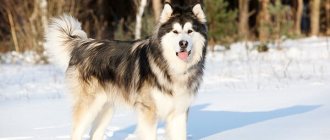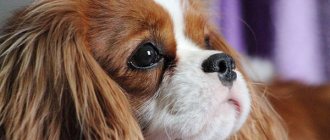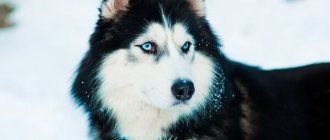Spaniels are a name that unites a large group of breeds, which includes hunting and decorative dogs, as well as dwarf dogs.
These include breeds such as the Cocker Spaniel, King Charles Spaniel, Irish Water Spaniel, Breton Espaniel, Japanese Chin and Sussex Spaniel.
Short and squat, with a stretched body, Sussex Spaniels are currently considered a rare and expensive breed.
These dogs have a rather unusual appearance.
They have shortened paws, thick fur, long ears and a calm, friendly look of light brown eyes.
Sussex Spaniels have not lost their hunting skills, but they can also be used as companions.
History of appearance
The Sussex Spaniel was bred in the south of Great Britain in the county of the same name at the end of the 18th century.
The creator of the breed, local landowner, politician and philanthropist John Fuller, set out to breed a hunting dog that could work successfully in local conditions.
The territory of Sussex County was covered with forest thickets and it was difficult for dogs of known breeds to work in the dense undergrowth.
In addition, it was required that the dog not only track down a hidden bird and bring killed game to the hunter. He also had to bark to point to the place where future prey was hidden.
To get such a dog, Fuller crossed several breeds of spaniels, in particular, the Norfolk spaniel, the field spaniel, the Clumber spaniel, and the English springer spaniel.
Thus, a dog was obtained that, in addition to having an excellent sense of smell and being able to track game in dense undergrowth, could also actively vocalize while working. This made the new breed stand out from the previously bred spaniels.
NOTE!
Representatives of this breed were first presented at an exhibition in London in 1862. And in 1884, the Sussex Spaniel became one of the first ten dog breeds recorded in the stud book of the American Kennel Club.
But at the same time, the Sussex Spaniel has never been very popular. So, in 1947, only ten puppies of this breed were registered in England. And, although the number of livestock has now increased significantly, in the UK they are among the vulnerable breeds.
Currently, the largest population of Sussex Spaniels is collected in the USA; as for Russia and the CIS, the number of dogs in these countries is extremely small.
Dog nicknames: names for Sussex Spaniels
Most people prefer to choose a short, sonorous name for their dog.
You will have to say your dog's name many times a day, and if it is too long, it will be tiring.
When choosing what to name a Sussex Spaniel, you can follow two methods.
- The first and easiest: open the list of the most suitable names for this breed and choose the one that you like best .
- Second: choose an unusual name from other sources, for example, from mythology or literature, name the dog after your favorite celebrity , or come up with your own exclusive name .
There are many suitable names for female Sussex Spaniels:
- Xena
- Joclyn
- Noel
- Delsie
- Mercy
- Zidane
- Peri
- Darla
- Bambi
- Goldenflower
The following names are good for a Sussex Spaniel boy:
- Yerokobi
- German
- Buzzi
- Humphrey
- Corbon
- Justin
- Archibalt
- Amiko
- Ilyusha
- Goyar
Photo and description of the breed
Sussex is a squat, massive spaniel with a very elongated format. Not too tall, but at the same time weighing quite a lot for a dog of his size. Outwardly similar to the Clumber Spaniel, but differs from it in slightly lower height at the withers, color and build.
A characteristic feature is slightly drooping eyelids, giving the Sussex Spaniel a phlegmatic expression, as well as its brownish coat, which shimmers with golden highlights in the sun.
Like other spaniels, Sussexes have long ears covered with silky hair, an almost square muzzle when viewed from the side, and a friendly and calm look.
These dogs can be used to find and retrieve game, but are also good as pets.
Appearance
The Sussex Spaniel is the largest representative of the spaniel breed. Representatives of the breed are distinguished by their strong, strong, massive physique. Despite their size and relatively large weight, the four-legged animals are very active and energetic.
Note! The Sussex Spaniel differs from its relatives not only in size, but also in its characteristic, proud, pendulum gait.
Regardless of gender, representatives of the breed must have a strong build. The official description of the breed indicates the range of dimensions without reference to gender:
- Height at withers: from 38 to 41 cm.
- Weight: from 22 to 24 kg.
Character traits
Sussex Spaniels are friendly to people and pets, and are loyal and devoted companions.
Possessing a lively but balanced and calm temperament, vigilance, an exceptionally good sense of smell, as well as efficiency, they can be used to find game and then retrieve it from the water or dense thickets.
Sussex Spaniels love to be in the company of their owners and are great with children. They are charming, positive, and many representatives of this breed are not even without a peculiar sense of humor.
The Sussex Spaniel may seem like a phlegmatic and slow dog, but in fact it is cheerful, playful and quite active .
Expert opinion
Kozhevin Semyon Kirillovich
Expert dog handler.
“Sussex Spaniels, bred for hunting in rough terrain and dense forests, have an interesting feature: these dogs use their voice to indicate to the hunter the place where future prey is hidden. Sussexes, having a loud voice with many intonations, barking with a certain timbre, can even tell the owner what kind of game they are pursuing. At home, these are friendly pets to other pets and people, who, despite their phlegmatic appearance, are active, love to play and communicate with their owners. They are balanced and calm enough not to irritate others with excessive energy and mobility. Sussex Spaniels make very good family pets as they are affectionate, good-natured and good with children.”
Temperament, behavior and use[edit | edit code]
Sussex is phlegmatic by nature, but can be active in certain situations. This dog gets along well with children and is suitable as a companion dog. The breed can be used as a gundog (functioning as both a pointing dog and a retriever), a companion dog, a therapy dog, or as a drug-trained police bloodhound. As a weapon, it works especially effectively in thickets and copses.
| Dog breeds |
| Australian Short-tailed Cattle Dog • Australian Shepherd • Australian Heeler • Australian Cattle Dog • Australian Kettle • Australian Terrier • Azawakh • Aidi • Alabai • Alano • Alpine Dachshund • American Water Spaniel • English Bulldog • English Coonhound • English Springer Spaniel • Appenzeller Mountain Dog • Affenpinscher • Greater Swiss Mountain Dog • White Swiss Shepherd • Barbet • Bergamasco Shepherd • Bichon Frize • Beauceron • Catahoula Bulldog • Buryat Mongolian Wolfhound • Welsh Corgi • West Highland White Terrier • East European Shepherd • Havanese Bichon • Gampr • Dutch Smoushond • Blue Gascony Basset • Dalmatian • Dandie Dinmont Terrier • Doberman Pinscher • Longhaired Collie • Drathaar • Eurasier • Wire Fox Terrier • Golden Retriever • Irish Water Spaniel • Yorkshire Terrier • Cane Corso • Kerry Blue Terrier • Cairn Terrier • Cromforlander • King Charles Spaniel • Shorthaired Collie • Komondor • Kuvasz • Kurzhaar • Labrador Retriever • Langhaar • Lhasa Apso • Mallorcan Shepherd • Maltese • Miniature Schnauzer • Pug • Moscow Watchdog • German Boxer • Auvergne Pointer • Otterhound • Puggle • Pekingese • Pyrenean Shepherd • Poodle • Puli • Pumi • Samoyed • Saint-Germain Braque • Slovakian Dude • Dachshund • Husky • Hovawart • Croatian Shepherd • Miniature Schnauzer • Chinook • Chihuahua • Swedish Lapphund • Shih Tzu • Sheltie • Sholoitzcuintle • Entlebucher Mountain Dog • Estrela Shepherd • Jagdterrier • Japanese Chin |
Advantages and disadvantages
Pros:
- Calm, balanced temperament.
- Friendly to other animals and people.
- They treat children well.
- Hardy and strong enough.
- They can be used during hunting both for searching, detecting and lifting game, and for delivering it from the ground or from the water.
- They work successfully in rough terrain and dense undergrowth.
- Original, but at the same time noble and elegant appearance.
- The only breed of spaniel in the world whose representatives vocalize while hunting.
- They are unpretentious and can adapt to different conditions.
- Can be kept in both rural areas and cities.
- They do not require complex coat care.
Minuses:
- They can be quite slow when searching for game and are more suitable for lovers of leisurely hunting.
- Sometimes they are stubborn, especially during training.
- Not the easiest breed to breed.
- They do not differ in a variety of colors.
- Expensive cost, and also the fact that the puppy’s future owners sometimes have to wait several months.
Breed dossier
1. Country of origin: United States of America.
2. Classification: Group 8. Retrievers, bird dogs, “water” dogs. Section 2. Dogs by bird.
3. Training: obedient dog, smart. Easy to train. It is unacceptable to use force or punishment against representatives of this breed. American Cocker Spaniels should be rewarded for good and reprimanded for bad, but you cannot beat or insult the dog, they are very sensitive to their owner and will forever stop trusting him.
4. Color: any solid color with or without tan, bicolor, tricolor.
5. Dimensions. Height at the withers: males: 36 - 38 cm, females 35 - 37 cm. Weight: 7 - 16 kg.
6. General impression. The American Cocker Spaniel has a charming appearance, harmonious proportions, and intelligent behavior. This is a strong, well built dog with a square format.
7. Use: hunting dog, companion dog.
8. Physical activity: active. The American Cocker Spaniel is an active, playful dog breed that loves movement. It is impossible to restrict the movement of the American Cocker; this may even make the dog sick. If you don't have the opportunity to walk this dog for several hours a day, come up with something else to do. Teach your American Cocker to help around the house, fetch his bowl if he wants to eat, or his leash if he wants to go for a walk. This way the dog will be able to show you exactly what it wants.
9. Temperament: American Cocker Spaniels are famous for their sociable, obedient nature and affectionate attitude towards their owners. This is an excellent companion dog, very sensitive and responsive. They are demanding and affectionate; representatives of this breed need a lot of attention. If you are not ready to pay so much attention to the dog and spend personal time on raising it, then it is better not to get a dog of this breed. American Cocker Spaniels should not be left alone for a long time, as this will undermine the dog’s trust in you and it will feel abandoned. This breed is absolutely not suitable for people who are constantly away and on long business trips.
10. Contents. American Cocker Spaniels are not suitable for keeping in rural areas. These dogs feel most comfortable in the house, next to their beloved owner.
11. Grooming: labor intensive. The American Cocker Spaniel needs to be carefully combed and constantly trimmed to highlight the unusual appearance of this dog. Periodically, American Cockers should have their nails trimmed and filed, their teeth examined and brushed, and their ears cleaned of wax and dirt from their eyes.
12. Accommodation: excellent. American Cocker Spaniels get along well with other pets in the house, they love small children and play with them.
13. Diseases: deafness, hip dysplasia, kidney disease, eye disease.
14. Diet: balanced. It is better to feed this dog with special food for decorative breeds of dogs and companion dogs, and give dietary supplements for good coat growth. Also, the American Cocker Spaniel needs to be fed with natural products - cottage cheese, meat, fish, etc.
15. Life expectancy: 14 – 16 years.
Characteristics of the standard
Head
Proportional and harmonious in relation to the body, quite wide and massive with a well-defined transition to the muzzle and developed brow ridges, giving the muzzle and gaze a phlegmatic, slightly gloomy expression.
Ears
Wide, large and rather thick, set low - approximately at the level of the outer corners of the eyes, covered with long, decorative hair.
Eyes
Expressive, oval, quite large. The color of the iris is hazel. The eyelids are slightly drooping, but hide most of the conjunctiva.
Nose
Brown.
Frame
Strong, rather squat, rectangular, elongated in format, with a short, wide back and deep chest.
Limbs
Strong, with a moderately wide set and well-developed muscles.
Tail
Currently, most often, it is left at natural length, but can also be docked and reach 12-17 cm in length. Quite thick, carried on the line of the back or below. The hair on the tail is long, thick and straight, giving it the appearance of a feather.
Wool
The guard hair on the body is moderately hard, straight and strong, the undercoat is dense, reminiscent of felt to the touch. There are featherings on the ears and back of the limbs.
Care and maintenance
Sussex Spaniels adapt well to both living conditions in a private home and a city apartment. They are helped in this by their small size and easy-going nature, thanks to which it is easy for them to get along with all family members. However, if the owners live in an apartment, the animal requires long walks, during which it can spend the energy accumulated during the day.
Grooming does not require any specific manipulations. It is enough to brush your dog 1-2 times a week. However, during seasonal shedding, dogs lose a large amount of hair, which is why owners will have to repeat brushing daily. Haircuts are usually not done. Particular attention should be paid to the ears, where tangles appear due to tangled hair. Ear wax should be cleaned with a soft cotton pad pre-moistened in warm water. Normally, the amount of wax should not be large, and the ears should not have an unpleasant odor.
The dog should be bathed 3 to 5 times a year and the coat should be cleaned as it gets dirty.
Nails should be trimmed using a nail clipper. Spaniels themselves can grind them down on the asphalt, so some owners prefer not to shorten the length. This can only be done with adult dogs, but puppies must have their nails trimmed.
To maintain dental health, you can feed your pet dry food or let him chew on large bones or other hard foods. This will help remove plaque and prevent the formation of tartar. It is also important not to forget about annual vaccinations and preventive examinations with a veterinarian. Thanks to this, you can not only maintain your pet’s health in good condition, but also promptly notice the development of pathologies.
Feeding
An adult animal needs food twice a day, while a puppy needs 5-6 meals a day. If owners prefer industrial feed, it is advisable to take a super-premium brand marked “Active”. With a natural diet, more than half of the diet should be meat and offal. The most preferable are beef, boiled heart, liver, lungs, tripe. However, the menu needs to be varied so that it includes not only meat products. You should also add there:
- cottage cheese;
- milk;
- eggs;
- sea fish;
- porridge (buckwheat, rice or oatmeal);
- vegetables (carrots, pumpkin);
- greenery.
The animal must be fed after physical activity, otherwise problems with the gastrointestinal tract may occur.
It is better to boil or steam food. This way all the nutrients are retained in the food.
Color variations
The most preferred color is a brownish color with a well-defined golden tint to the coat and the same shade to the tips of the hair. Also considered acceptable, although less valued, are bright brown and reddish brown shades.
IMPORTANT!
Previously, black and fawn colors were acceptable for Sussex Spaniels, but these are not currently recognized as the standard.
Clothes for Sussex Spaniels
In extreme cold, Sussex Spaniels can freeze because they have little fluff under their coats. Owners should insulate their pet by buying him winter clothes.
Buying clothes for a Sussex Spaniel is now easy. Many stores selling clothing for animals have in their assortment stylish and beautiful things for dogs of all breeds.
Relationship with other pets and children
Sussex Spaniels are good with children. They are calm and good-natured enough to not pay attention to children's pranks, although they do not like to be teased.
Phlegmatic and slow at first glance, these dogs show activity and mobility while playing with their little owners.
Typically, Sussexes are quite friendly towards other pets with the exception of birds.
They are calm, reasonable and try not to get into conflicts with other dogs and cats.
Training and education
Sussex Spaniels are highly trainable. It is best to spend it in the fresh air, alternating learning new commands with active games. This way the animal will not only train skills, but also develop physical fitness. To do this, you should choose a place where you can let the dog off the leash and let it run. When training, it is important not to forget about the breed’s character traits. Due to natural phlegmatism, the animal can slowly, and sometimes even reluctantly, carry out commands. Therefore, owners need to be patient and reinforce their pet’s successes with treats.
How to properly care?
The Sussex Spaniel's coat should be brushed at least once a week, and during shedding - daily, trying to remove all dead undercoat. They bathe the dog as needed, since frequent washing is harmful for representatives of this breed, and insufficiently dry undercoat can cause skin diseases.
Long, floppy ears are recommended to be cleaned once every 1-2 weeks and inspected daily.
The Sussex Spaniel's eyes also require regular care. They need to be inspected every day and, if necessary, wiped with a damp cotton pad dipped in a special eye cleaner, which can be purchased at a veterinary pharmacy.
NOTE!
Your pet's teeth should be cleaned with a toothbrush and toothpaste for dogs. It is also useful for prevention to let him chew on hard treats or toys to clean them.
The claws are shortened if necessary, and it is recommended to use a nail clipper rather than scissors or nail clippers, as otherwise the claw may split.
Choosing a Sussex Spaniel puppy
When purchasing a puppy, in order to avoid disappointments and litigation, you should remember the following points:
- The puppy must be over 6 weeks old - breeders usually strive to “mix” puppies as early as possible, but most often puppies taken from their mother too early grow up weak and sick;
- on the pedigree (if possible, with photographs) and on the parents of the puppy - the painful appearance immediately catches the eye;
- you should not buy the smallest puppy - most likely, he will have health problems in the future;
- obtain confirmation of deworming and vaccination (vaccinations are given from two months);
- if the first (fifth) fingers were docked or removed, make sure that the wounds have healed and healed normally;
- clarify what kind of feeding the puppy received.
- If the puppy is inactive, the coat seems faded, and the body is too fragile - it is better not to choose this puppy. A healthy puppy should be mobile, active, with shiny thick hair and a strong body.
Life expectancy and major diseases
Sussex Spaniels live 12-15 years and are generally in good health.
However, these dogs may be predisposed to certain diseases, such as:
- Hip dysplasia.
- Otitis.
- Adenoma of the third century.
- Glaucoma.
- Inversion or inversion of the eyelids.
- Conjunctivitis.
- Blockage of the lacrimal gland.
- Cataract.
- Retinal atrophy.
- Diseases of the oral cavity (tartar, periodontal disease, caries, pulpitis, stomatitis).
- Diseases of the cardiovascular system, among which the most common are pulmonary valve stenosis and patent ductus arteriosus.
- Slipped disc syndrome.
Before buying a puppy, you need to check whether its parents have medical certificates.
Price
Buying a spaniel is not easy. Advertisements can be found on the Internet, on special boards on city streets, and even on lampposts. But such a purchase is sometimes risky if you want to acquire a purebred “specimen.” The best way out is to contact a nursery.
Then the chosen baby will be healthy and with all the necessary documents. Although, if your goal is not to participate in exhibitions, acquire a hunting companion, or make money from mating, it is quite possible to adopt a puppy from the author of a private ad. But before that, it’s good to look at it and get as much information and all the necessary documents from the seller as possible.
The price of a Russian Cocker Spaniel depends on the place where it is bought. A private owner can sell a puppy for fifty to one hundred dollars. A “premium class” baby from a nursery with a solid reputation will cost about six hundred, but there are also much more expensive ones, far over a thousand. On average, a purebred little friend can cost in the range of three hundred to four hundred dollars.
Nutritional Features
You can feed your pet ready-made food or natural food prepared at home.
If you decide to feed your dog with ready-made food, then you need to choose a brand that matches the dog’s age, size, activity and physical condition.
When feeding natural food, about 2/3 of the diet should be meat and offal. It is recommended to add buckwheat, rice or oatmeal to them. Fermented milk products, raw or boiled vegetables and boiled boneless sea fish, which can replace meat once a week, will also be a useful addition to the diet.
You should not feed your dog before a walk or hunt, as physical activity can cause bloating or bloating.
It is recommended to give your pet food no earlier than two hours after a walk.
In addition, it should be noted that Sussex Spaniels are insatiable and will eat endlessly. It is necessary to limit your pet's food, giving it only the prescribed portion and not feeding it additionally in between feedings.
Walks
A dog kept in an apartment must be walked at least 2 times a day (morning and evening). Young Sussex Spaniels are walked more often, approximately 3-4 times a day. Each walk usually takes 25–30 minutes.
When walking, Sussex Spaniels can be let off a leash if they are walked on a special playground. However, they behave very roughly even when they are on the street.
In hot weather, you should take your pet for walks early in the morning and after sunset, as Sussex Spaniels do not tolerate high temperatures well.
How to choose a puppy?
The Sussex Spaniel is a very rare and expensive breed not only in Russia, but throughout the world, and the choice of such a pet must be approached responsibly.
It is not recommended to buy a puppy without documents, since all purebred dogs of this breed are kept either in kennels or from private breeders, but not from breeders.
In addition, it is very important that the puppy belongs to healthy lines: its parents must have medical certificates. If a Sussex is purchased for hunting, it is advisable that its father and mother also have field test diplomas.
NOTE!
A good Sussex Spaniel puppy looks quite strong and stocky, but not too bulky. It has fairly short, thick legs, a stretched but not too long body, wide, low-set ears and a shiny coat of the typical golden brown color of the breed.
The puppy's look should be calm and friendly, and his behavior should be free of both cowardice and aggressiveness.
Sussex Spaniels pregnancy and birth
From the day of the first mating to the birth itself, 56 to 72 days . It is advisable to note the day of mating in order to know how long the dogs are pregnant. Too early and too late births most often lead to the death of the litter, so in both of the above cases it is necessary to seek help from a qualified veterinarian. The gestation period in dogs may be shortened due to the small number of offspring.
Typically, young females produce fewer puppies.
The litter size increases when the dog reaches 3-4 years of age, then decreases again. The duration of pregnancy in dogs is not very long; it is not so easy to determine that a dog is pregnant.
Obvious signs of pregnancy in dogs appear at quite late stages. Neither palpation nor the appearance of the pet at an early stage of pregnancy will tell the owner whether the mated bitch is expecting offspring or not. The first signs concern not so much the external appearance as the mental state, and therefore the behavior of the pregnant bitch. The dog, as a rule, becomes calmer, shows affection more often and demands affection from others. Sometimes the animal may not even seem completely healthy.
If the pregnancy is progressing normally, the specialist can establish pregnancy by palpation in the third week. After a month, the dog’s belly noticeably enlarges, and in the fifth week the mammary glands swell and lighten. Shortly before giving birth, the bitch's belly drops. A characteristic sign of approaching labor is abundant discharge from the loop, yellowish or greenish in color.
Also prepare a “maternity kit” so that everything you need is at hand, it should include:
- old duvet covers or large disposable diapers (60*90), on which the bitch will whelp (disposable diapers are preferable - less washing and more cleanliness);
- a lot of small soft rags ironed with a hot iron from old bedding (to dry puppies);
- sterile gauze wipes (usually unnecessary, the puppy’s mouth is dried with a piece of cloth, into which, in fact, the puppy is received);
- a pen, a notebook, scales and thick woolen threads or ribbons (it is better to use floss, because the bitch simply licks and removes woolen threads);
- afterbirth bowl;
- a box or basin for puppies with a heating pad (wrapped in a diaper) - this is in case the bitch behaves restlessly during childbirth and there is a risk of losing puppies... the best option is a bitch giving birth with puppies at the nipples;
- sterile scissors and a medical clamp (it is not necessary to boil; at the onset of labor, place in a jar with any alcohol);
- milk chocolate bar;
- an antiseptic, preferably a spray (Aluminium, Xidicol, Septonex) for treating the umbilical cord.
And also a puppy resuscitation kit:
- cordiamine to stimulate cardiac activity (a drop on the tongue of a newborn);
- an oxygen canister (to give a weak puppy a chance to breathe), costs about 400 rubles in pharmacies;
- small rubber heating pad;
- a small enema for suctioning mucus from the mouth of a very weak puppy.
As for medications, during a normal birth they will not be needed, and if you had to resort to the help of a veterinarian, then he will have the necessary kit. Just in case, you can keep in stock No-shpu in ampoules, glucose 5% solution for infusion; calcium gluconate (a box, may be useful after childbirth).
You will also need a watch to mark the time of birth of the puppies and a notepad to record the details of the whelping (they will come in handy in the future), with your veterinarian's phone number displayed in a visible place. It's also great to have a scale for weighing newborn puppies. The puppy's birth weight, among other whelping details, should also be recorded in a notebook.
Bitches usually whelp between 58 and 63 days. Large litters are born earlier, and small ones a little later.
In the last days before whelping, you need to monitor the bitch’s body temperature. The normal temperature measured in the anus is about 38.5°C. Two days before giving birth, the bitch's temperature usually drops to 37°C or even lower. But since this does not always happen, you need to be attentive to all other signs of impending whelping. And yet, more often than not, if the temperature remains normal, then the bitch is unlikely to whelp in the next 24 hours.
Before whelping, it is good to give the bitch a mild laxative to help her cleanse her intestines.
It is better if, 2-3 days before the expected birth, you call a veterinarian or clinic, warning in advance about a possible call; in any case, the necessary phone numbers should be in a visible place.
Nurseries in Russia and CIS
Currently in Russia there are the following main nurseries engaged in breeding Sussex Spaniels:
- Memfestor's (Moscow)
- Labry Berry (Ryazan)
- From Roman's House (Ivanovo region)
Contact information for these nurseries can be found on the Internet - on their websites or on social networks.
For the CIS countries, there is no information about nurseries, since the owners of the Sussexes available there either do not engage in breeding at all, or do it as private breeders.
English Cocker Spaniel – price and how to buy it correctly
A smart decision would be to purchase a cocker spaniel from professional breeders or from a kennel that has been breeding dogs for many years.
Of course, this breed is quite common, and you can buy a cocker cheek at any “bird” market for 2-3 thousand rubles, but no one can guarantee that it will be a purebred dog without hereditary diseases.
First of all, you need to choose the gender of the puppy. If you plan to hunt with a dog, then you need to choose a female, as they are obedient, smart and less obstinate than males. Then you need to see the dog’s parents and make sure that they do not have obvious diseases or genetic abnormalities.
An overly timid and lethargic puppy is more likely to end up overweight or overwhelmed, and will have serious mental problems in the future.
The selected puppy must fully comply with breed standards, have no birth defects and have a stable psyche. The nursery must issue all the necessary documents for each puppy sold, as well as a passport indicating the vaccinations received.
You can buy a good spaniel puppy from breeders for 6-10 thousand. Such dogs are not intended for breeding, but they will become good companions at home and on the hunt.
A purebred show-class puppy will cost 15-30 thousand rubles. This cocker can be used for breeding and taken to all possible exhibitions.
The English Cocker Spaniel is a magnificent breed of dog. Representatives of this breed serve in the army, searching for mines, helping police officers search for drugs, and are considered one of the best beaters of game birds. Get this dog, and it will become a reliable companion and loyal friend for many years.

